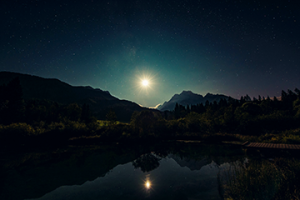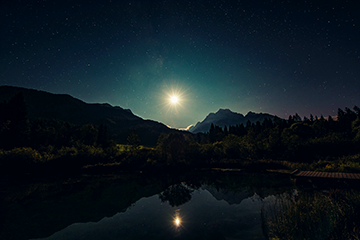 Some sing, “O Holy Night.” Some sing, “Silent Night.” Some sing, “It Came upon a Midnight Clear.” Christmas, it would seem, is a festival of the middle of the night. Jesus was born when it was dark, dark midnight. We are sure of it. And why shouldn’t we be?
Some sing, “O Holy Night.” Some sing, “Silent Night.” Some sing, “It Came upon a Midnight Clear.” Christmas, it would seem, is a festival of the middle of the night. Jesus was born when it was dark, dark midnight. We are sure of it. And why shouldn’t we be?
Even though we are not told the exact hour of His birth, we are sure that it must have been at night. Scripture does say that the shepherds who heard the glad tidings were keeping watch over their flock by night (cf Luke 2:9). Further, the Magi sought him by the light of a star, and stars are seen at night—deep midnight. None of this is evidence that Jesus was born at 11:59 PM, but it sets our clocks for nighttime—deep midnight.
Add to this the fact that Christmas is celebrated near the winter solstice, the very darkest time of the year in the northern hemisphere. More specifically, Christmas breaks in on the very days when the light begins its subtle return. The darkest and shortest days of the year are December 21st and 22nd. By December 23rd and 24th, we notice a definite but subtle trend: the days are getting longer; the light is returning! It’s time to celebrate the return of the light; it’s going to be all right!
How fitting it is to celebrate the birth of Jesus, the true Light of the World, in deep and dark December. Jesus, our light, kindles a fire that never dies away. Indeed, in the dark hours of late December, we notice a trend. The light is returning; the darkness is abating; the days are growing longer from this point on. It is subtle now, but it will grow! And with the return of light, we celebrate our True Light: Jesus.
But light is best appreciated in contrast. We are most grateful for the glory of light when darkness assails us. There’s just something about Christmas Eve! As the date approaches and the darkness grows, we light lights. All through December, as the darkness grows we light Advent candles. We light more as it grows darker. Even the secular among us string lights during dark December, in malls and on houses. It’s as if to say, the darkness cannot win; the light conquers!
Lights have their true glory in contrast to the darkness. Who sees the stars at midday? Who appreciates the beauty of light until he has experienced the darkness? Yes, Christmas is a feast of the light. We confront the darkness of December and declare to it, your deepest days are over; the light is returning. And we of faith say to a world in ever-deeper darkness, your darkness cannot remain; it will be overcome and replaced. For though darkness has its season, it is always conquered by the light.
Light has a way of simply replacing the darkness. On December 22nd/23rd, the darkness begins to recede; the light begins to return. It is almost as if the darkness takes up the words of John the Baptist: He [Jesus] must increase, I must decrease. It seems subtle at first, but the light always returns; the darkness cannot last. In three months, the equinox occurs; in six months the summer solstice comes. The darkness will once again seek to conquer, BUT IT ALWAYS LOSES. The light will return. Jesus is always born at the hour of darkness’ greatest moment. Just when the darkness is celebrating most, its hour is over; the light dawns again.
Yes, we celebrate after sundown on December 24th in accord with a tradition going back to Jewish times (that our Feasts begin at sundown on the previous night). Christmas morning is almost an afterthought. Most pastors know that the majority of their people have come the “night before.” In a deep and dark December, a light comes forth, a star, and shines in the heavens.
We gather in and on a dark night. We smile. We are moved by the cry of a tiny infant, by whose voice the heavens were made. His little cry lights up the night. The darkness must go; the light has come; day is at hand.
Yes, we celebrate at night to bid farewell to the darkness. It cannot prevail. The darkness is destined to be scattered by a Light that is far more powerful, a Light it must obey, a Light that overwhelms and replaces it. Farewell to darkness; the Light of the World has come.
Jesus is the Light of the World.
The videos below are a celebration of light. As a Christmas gift to myself last December 22nd, the darkest day of the year, I took the afternoon off and went to photograph the triumph of light over darkness. I went to a Mausoleum—yes, to a place where thousands are buried in the walls. But also in those walls are windows, glorious windows where light breaks through and Christ shines forth. Some of the most beautiful stained glass in the city of Washington, D.C. reside in that place of death and darkness. The light breaks through and it speaks of Christ.
These videos are a testimony to just some of those windows. In this place, a place of death, a light breaks through: the light of faith, the Light of Christ. The lyrics in the first video are from Taizé: Christe, lux mundi, qui sequitur te habebit lumen vitae, lumen vitae (Christ, light of the world, who follows you has the light of life, the light of life). The second video features verses from the “Canticle of the Three Children” in the Book of Daniel.
As you view these videos, ponder the fact that stained glass begins as opaque sand. But when subjected to and purified by the fire, it radiates the glory of light, which can now shine through it. So it is for us. Born in darkness, but purified by Christ and the fire of the Spirit, we begin to radiate His many-splendored Light shining through us to a dark world.
The Light wins. He always wins.


Jesus, God become man, is born at a time when it is cold and dark, and he is arrested when it is cold and dark and he rises from the dead when it is cold and dark — not only time of day, but in human history, in the human condition.
Now, the cold and dark do not have a reality in themselves, a substance in themselves, rather they are the absence of a reality, they are the absence of light and heat, of an energized active state. With humanity, that means an absence of something too, the absence of light and warmth, that is, the absence of love and truth — i.e. it is a state of sin, a static existence, not a truly active one.
Cold and dark are also when most people are asleep, not only physically, but also spiritually. It is when people are no longer aware, they no longer even realize their state of sin.
Jesus comes to wake people up, to stir them out of their slumbering consciences, their lack of awareness, to revitalize and energize them and fill the emptiness, the absence of God.